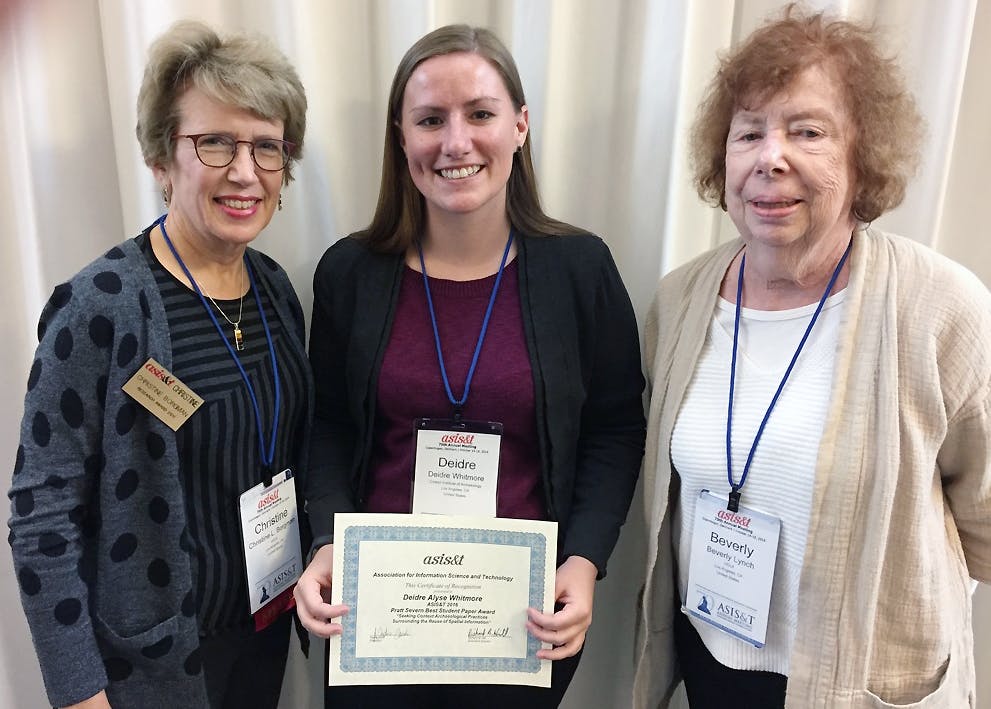Deidre Whitmore (B.A., Anthropology; ’16, MLIS, Informatics) has been to some fascinating archaeological sites – including digs in Easter Island, the Fayum region in Egypt, Ethiopia, and Japan. Ultimately, her interest in the management of geospatial data has unearthed a gem for her CV: the Pratt Severn Best Student Research Paper Award from the Association for Information Science and Technology (ASIS&T). She was presented with the award at the international conference of ASIS&T in Copenhagen last October, and the paper titled, “Seeking Context: Archaeological Practices Surrounding the Reuse of Spatial Information,” may be published in the Journal of the Association for Information Science and Technology.
Whitmore, who currently serves as Digital Archaeology Lab and Data Publication Manager for the Cotsen Institute of Archaeology at UCLA, began working there during her undergraduate years. She says that while working on a variety of projects, including the Easter Island Statue Project, she would gravitate toward the database. Her experiences led her to the MLIS program at UCLA where she began researching data management and preservation in archaeology.
“A lot of my work involved going back and finding previous data that had been collected by other archaeologists or enthusiasts, and to reuse that,” Whitmore says. “In archaeology, it’s very difficult to recollect information because if you excavate deep down, you lose the context and you can’t go back and redig that area.

“If information is not documented correctly the first time, it’s really hard to understand what came out of it. I spent a lot of time trying to salvage what had already been published or saved in an archive somewhere, and I realized I wanted to make this [process] better.”
Whitmore says that within archaeology and its study of the past, “so much is linked to a specific place – not just a place in time, but to a location on Earth and the depth [of the excavation] itself.”
“Because we study a lot of information that was collected before people had GPS units, there might just be a textual description: ‘You turn right when you get to this giant rock, left at the bush.’ [Scholars] were trying to [find information] from – these half-done sketches they found or field notes that people had collected. Trying to figure out if these are imprecise or not is difficult, because it involves traveling to the location and checking it. You may not be able to go back to that exact place again.”
Whitmore says that the interdisciplinary nature of collecting and analyzing archaeological data gives it a unique diversity.
“Because [archaeology] is interdisciplinary, you’ll have so many specialists working on one team, [all] focused on a very particular aspect of an artifact or a certain kind of artifact,” she says. “Someone could be working on ceramics; someone else could be studying lithics or tools versus vessels. Trying to incorporate all that [data] together into something functional so that someone can go back and understand how it was collected, is challenging.”
Whitmore says that a similar interdisciplinary approach to the field of cataloguing is essential, and that her experience of meeting other professionals in the field at the ASIS&T conference was illuminating.
“A lot of what I do pulls [expertise] from other fields,” she says. “Seeing how other researchers have addressed the same sorts of problems in other disciplines and seeing if there are ways we can adopt that is helpful.”
Whitmore is currently helping to build a data publishing platform for the Cotsen Institute of Archaeology Press. She is also managing a new digital archaeology lab for the Cotsen Institute, working with graduate students and faculty on data management and enforcing best practices in the field.
Above: Deidre Whitmore, Digital Archaeology Lab and Data Publication Manager for the Cotsen Institute of Archaeology at UCLA, stands in a carved hole called a “pu” at the top of the statue quarry at Easter Island. Whitmore and her colleagues were creating a 3D model of the pu and the surrounding area.
Photo by Greg Downing
